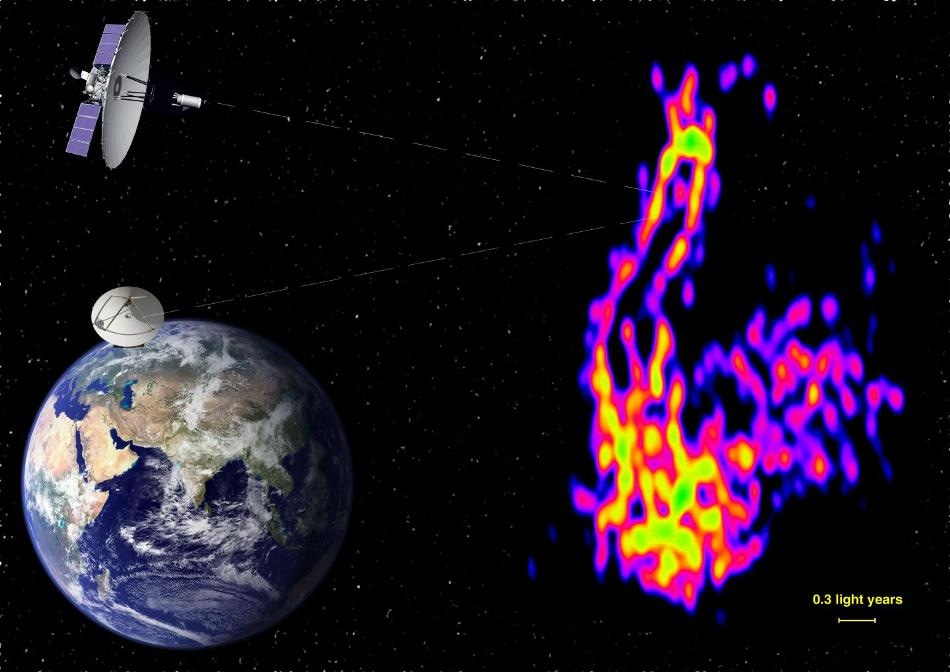Apr 5 2018
At the centers of all enormous galaxies are black holes weighing nearly several billion times the mass of our sun. It is common knowledge for long that some of these colossal black holes eject spectacular plasma jets at a near speed-of-light that can spread far beyond the limits of their host galaxy. But how these jets develop in the first place has been an enduring mystery.
One of the key challenges in examining them has been astronomers’ inability to image the structure of the jets driven by the black hole close enough to their induction site so that direct comparison to theoretical and computational models of jet formation would be doable.
 Artistic composition of the radio telescopes in space and on the ground observing NGC 1275, the central galaxy of the Perseus cluster of galaxies at a distance of 230 million light years. This radio image shows a newly forming jet that is about three light years long. The central black hole is inside the bright spot at the top of the image. The details visible in the image are smaller than the Oort's comet cloud around our solar system. (Image credit: Pier Raffaele Platania INAF/IRA (compilation); ASC Lebedev Institute (RadioAstron image))
Artistic composition of the radio telescopes in space and on the ground observing NGC 1275, the central galaxy of the Perseus cluster of galaxies at a distance of 230 million light years. This radio image shows a newly forming jet that is about three light years long. The central black hole is inside the bright spot at the top of the image. The details visible in the image are smaller than the Oort's comet cloud around our solar system. (Image credit: Pier Raffaele Platania INAF/IRA (compilation); ASC Lebedev Institute (RadioAstron image))
Currently, an international team of researchers from eight different countries have developed ultra-high angular resolution images of the black hole jet at the center of the giant galaxy NGC 1275, also called radio source Perseus A or 3C 84. The team was able to resolve the jet structure ten times closer to the black hole in NGC 1275 than formerly possible with ground-based instruments, exposing unparalleled details of the jet formation region.
The results were surprising. It turned out that the observed width of the jet was significantly wider than what was expected in the currently favoured models where the jet is launched from the black hole’s ergosphere – an area of space right next to a spinning black hole where space itself is dragged to a circling motion around the hole.
Professor Gabriele Giovannini, Lead Author - Italian National Institute for Astrophysics
This may imply that at least the outer part of the jet is launched from the accretion disk surrounding the black hole. Our result does not yet falsify the current models where the jets are launched from the ergosphere, but we hope it will give the theorists an insight into the jet structure close to the launching site and clues about how to develop the models.
Dr. Tuomas Savolainen, Head of the RadioAstron Observing Program
Another result from the research is that the jet structure in NGC 1275 considerably differs from the jet in the very close galaxy Messier 87, which is the only other jet whose structure has been imaged in the same way close to the black hole. Researchers think that this is because of the difference in the age of these two jets.
“The jet in NGC 1275 was re-started just over a decade ago and is currently still forming, which provides a unique opportunity to follow the very early growth of a black hole jet. Continuing these observations will be very important", explains a co-author of the paper, Dr. Masanori Nakamura from Academia Sinica in Taiwan.
“This study of the innermost region of NGC 1275 continues our investigations of Active Galactic Nuclei at the highest possible resolution. As the distance to that galaxy is only 70 Megaparsec or 230 million light years, we are able to examine the jet structure with an unprecedented accuracy of only a few hundred black hole radii or 12 light days”, concludes Professor Anton Zensus, director at the Max Planck Institute for Radio Astronomy in Bonn, Germany and head of its VLBI research department, a co-author of the paper.
One Radio Telescope in Space – Dozens on the Ground
The noteworthy improvement in the sharpness of the jet images was achievable due to the Earth-to-Space Interferometer RadioAstron, which comprises a 10-meter orbiting radio telescope and a collection of around two dozen of the world’s largest ground-based radio telescopes. When the signals of single telescopes are united using the interference of radio waves, this array of telescopes has the angular resolution corresponding to a radio telescope of 350 000 km in diameter – nearly the distance between the Earth and Moon.
This puts the RadioAstron in first position as the highest angular resolution instrument in the history of astronomy. The RadioAstron project is led by the Astro Space Center of the Lebedev Physical Institute of the Russian Academy of Sciences and the Lavochkin Scientific and Production Association under a contract with the State Space Corporation ROSCOSMOS, in collaboration with partner organizations in Russia and other countries.
We at the RadioAstron mission are truly happy that the unique combination of the Russian-made space radio telescope and the huge international ground array of the largest radio telescopes has allowed to study this young relativistic jet in the immediate vicinity of the supermassive black hole.
Professor Yuri Kovalev, RadioAstron Project Scientist - Lebedev Institute, Moscow